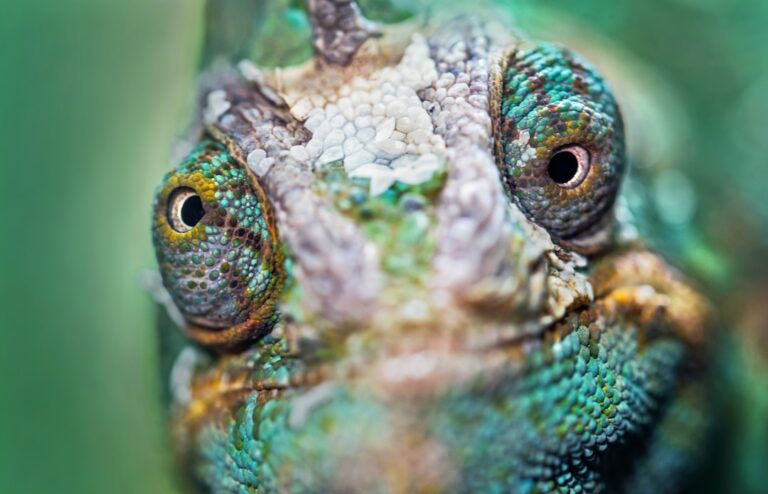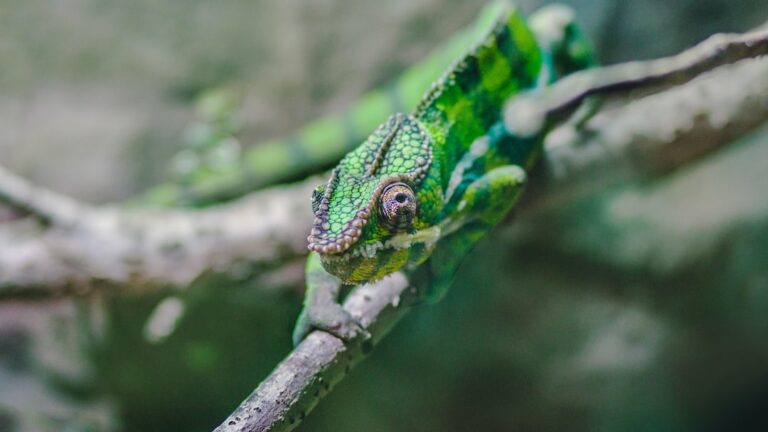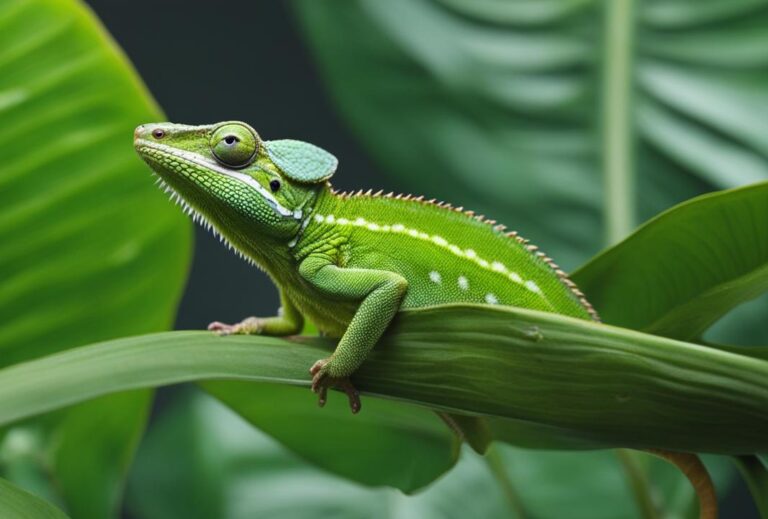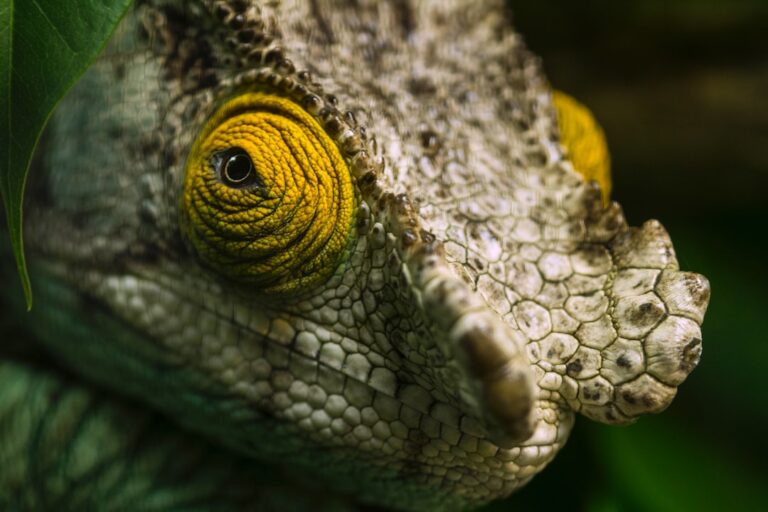Are Chameleons Blind?
Chameleons are fascinating creatures known for their ability to change color and blend into their surroundings. They are often associated with their unique eyes, which can move independently of each other. However, the mystery of chameleon sight goes beyond just their eye movement. How do chameleons see the world around them? How do they use their eyes to hunt and communicate? In this article, we will explore the anatomy of a chameleon’s eye, how they use their eyes to hunt, the importance of color vision in chameleons, and debunk the myth of chameleon blindness.
Table of Contents
Anatomy of a Chameleon’s Eye
The physical structure of a chameleon’s eye is quite different from that of other animals. Chameleons have large, bulging eyes that are positioned on either side of their head, giving them a wide field of vision. Each eye is capable of moving independently, allowing them to look in different directions simultaneously. This unique feature gives chameleons a 360-degree view of their surroundings without having to move their head.
Another interesting feature of a chameleon’s eye is its ability to focus on both near and distant objects. The lens in their eye can change shape to adjust the focal length, allowing them to see clearly at various distances. This is particularly useful for hunting, as it enables them to accurately judge the distance between themselves and their prey.
How Chameleons Use Their Eyes to Hunt
Chameleons primarily use their eyes to locate and track prey. Their ability to move each eye independently allows them to scan their surroundings for any signs of movement. Once they spot potential prey, they focus both eyes on the target and calculate the distance using depth perception.
Depth perception is crucial for chameleon hunting. It allows them to accurately judge the distance between themselves and their prey, enabling them to strike with precision. This is especially important when hunting insects, as chameleons need to accurately calculate the distance and trajectory of their tongue to catch their prey.
The Importance of Color Vision in Chameleons
Color vision plays a vital role in the lives of chameleons. They use their ability to see a wide range of colors to communicate with each other and establish dominance. Male chameleons, in particular, use vibrant colors to attract females and intimidate rivals.
Chameleons have specialized cells in their eyes called cone cells, which are responsible for color vision. These cone cells allow them to see a wide spectrum of colors, including ultraviolet light that is invisible to humans. This gives chameleons an advantage when it comes to detecting subtle color changes in their environment and communicating with other chameleons.
The Myth of Chameleon Blindness
Contrary to popular belief, chameleons are not blind. In fact, they have excellent vision that is well-suited for their unique environment. The myth of chameleon blindness likely stems from their ability to blend into their surroundings and remain undetected by predators.
Chameleons have adapted to their environment by developing specialized vision that allows them to see clearly in both bright sunlight and low light conditions. Their eyes are highly sensitive to movement, allowing them to quickly detect any potential threats or prey.
How Chameleons Adapt to Different Light Conditions
Chameleons have a unique adaptation that allows them to adjust their vision in different light conditions. They have a specialized structure called the iris, which controls the amount of light entering the eye. In bright sunlight, the iris contracts, reducing the amount of light that enters the eye and preventing damage. In low light conditions, the iris expands, allowing more light to enter the eye and improving visibility.
This ability to adapt to different light conditions is crucial for chameleons, as they often inhabit areas with varying levels of light. It allows them to see clearly and accurately assess their surroundings, whether they are in a brightly lit forest or a dimly lit jungle.
The Role of Eye Movement in Chameleon Vision
Eye movement is essential for chameleon vision. Chameleons use their eyes to scan their environment and locate potential prey or threats. Their ability to move each eye independently allows them to have a wide field of vision and quickly detect any movement.
Chameleons also use eye movement to track their prey. Once they spot a potential meal, they focus both eyes on the target and follow its movements. This tracking ability is crucial for hunting, as it allows chameleons to anticipate the movements of their prey and strike at the right moment.
Chameleon Vision Compared to Human Vision
Chameleon vision is quite different from human vision. While humans have binocular vision, which allows us to perceive depth and judge distances accurately, chameleons have monocular vision. This means that each eye sees a slightly different image, and the brain combines these images to create a three-dimensional view of the world.
Chameleons also have a wider field of vision than humans. Their eyes are positioned on the sides of their head, giving them a 360-degree view of their surroundings. This allows them to be aware of potential threats from all directions and quickly respond to any danger.
Common Misconceptions About Chameleon Sight
There are several common misconceptions about chameleon sight that need to be debunked. One misconception is that chameleons can see in all directions at once. While it is true that they have a wide field of vision, they cannot see behind themselves or directly in front of their nose.
Another misconception is that chameleons can change color to match their surroundings. While chameleons can change color, it is not for camouflage purposes. They change color in response to their mood, temperature, or social interactions, rather than to blend into their environment.
Understanding Chameleon Vision
In conclusion, chameleon vision is a fascinating and complex topic. Chameleons have unique eyes that allow them to see a wide range of colors, track prey with precision, and adapt to different light conditions. They are not blind, as commonly believed, but have excellent vision that is well-suited for their environment.
Understanding chameleon vision is crucial for their survival and conservation. By studying their eyes and how they use them to hunt and communicate, we can gain valuable insights into their behavior and develop strategies to protect them in the wild. Chameleons are truly remarkable creatures, and their vision is just one of the many mysteries that make them so intriguing.
If you’re interested in learning more about chameleons, you might also want to check out this article on “Do Chameleons Blink?” It explores the fascinating behavior of chameleons and discusses whether or not they have the ability to blink. To read more about it, click here.







